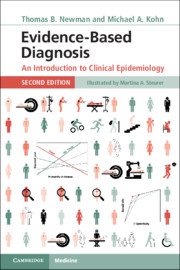Book contents
- Evidence-Based Diagnosis
- Evidence-Based Diagnosis
- Copyright page
- Dedication
- Contents
- Preface
- Acknowledgments
- Chapter 1 Introduction
- Chapter 2 Dichotomous Tests
- Chapter 3 Multilevel and Continuous Tests
- Chapter 4 Critical Appraisal of Studies of Diagnostic Test Accuracy
- Chapter 5 Reliability and Measurement Error
- Chapter 6 Risk Predictions
- Chapter 7 Multiple Tests and Multivariable Risk Models
- Chapter 8 Quantifying Treatment Effects Using Randomized Trials
- Chapter 9 Alternatives to Randomized Trials for Estimating Treatment Effects
- Chapter 10 Screening Tests
- Chapter 11 Understanding P-Values and Confidence Intervals
- Chapter 12 Challenges for Evidence-Based Diagnosis
- Answers to Problems
- Index
- References
Chapter 12 - Challenges for Evidence-Based Diagnosis
Published online by Cambridge University Press: 02 May 2020
- Evidence-Based Diagnosis
- Evidence-Based Diagnosis
- Copyright page
- Dedication
- Contents
- Preface
- Acknowledgments
- Chapter 1 Introduction
- Chapter 2 Dichotomous Tests
- Chapter 3 Multilevel and Continuous Tests
- Chapter 4 Critical Appraisal of Studies of Diagnostic Test Accuracy
- Chapter 5 Reliability and Measurement Error
- Chapter 6 Risk Predictions
- Chapter 7 Multiple Tests and Multivariable Risk Models
- Chapter 8 Quantifying Treatment Effects Using Randomized Trials
- Chapter 9 Alternatives to Randomized Trials for Estimating Treatment Effects
- Chapter 10 Screening Tests
- Chapter 11 Understanding P-Values and Confidence Intervals
- Chapter 12 Challenges for Evidence-Based Diagnosis
- Answers to Problems
- Index
- References
Summary
We wrestled for a long time with the question of whether to include the term “evidence-based” in the title of the first edition of this book. Although both of us are firm believers in the principles and goals of evidence-based medicine (EBM), as articulated by its first proponents[1] we also knew that the term “evidence-based” would be viewed negatively by some potential readers [2–4]. We decided to keep “evidence-based” in the title and use this chapter to directly address some of the criticisms of EBM, many of which we believe have merit. We also recognize that, as elegant and satisfying as evidence-based diagnosis is, there are some very real cognitive barriers to applying it in a clinical setting. These barriers are the second topic of this chapter. Finally, we end the book with some thoughts on the future of evidence-based diagnosis and why it will be increasingly important.
- Type
- Chapter
- Information
- Evidence-Based DiagnosisAn Introduction to Clinical Epidemiology, pp. 303 - 317Publisher: Cambridge University PressPrint publication year: 2020

